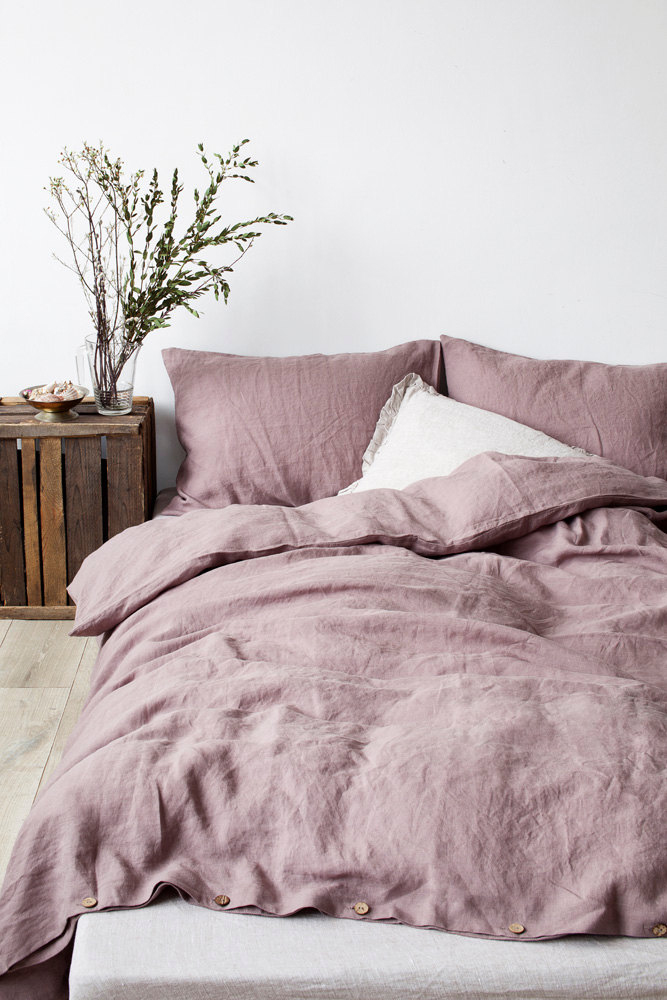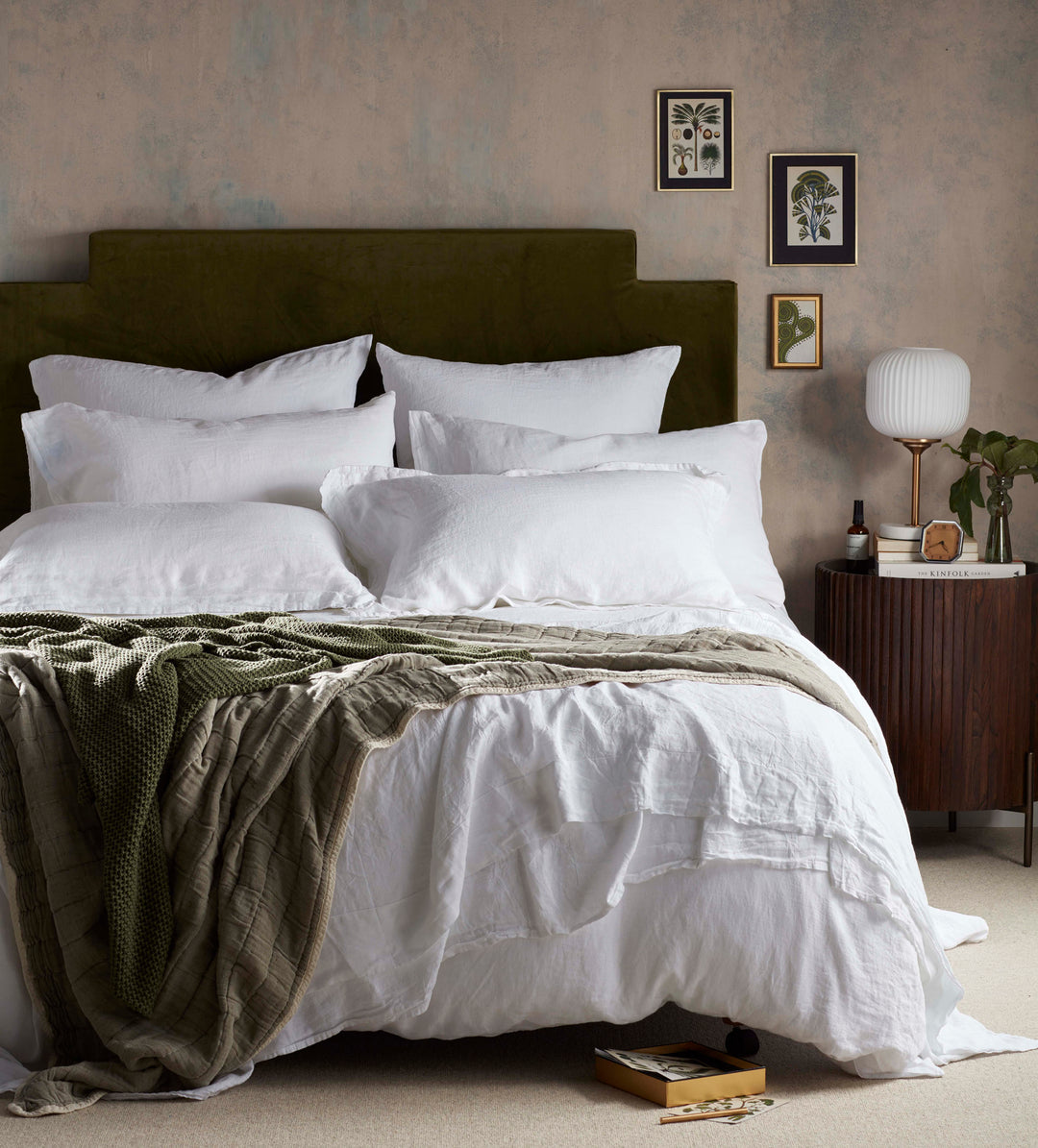Everything You Need to Know About Washing and Drying Linenshed Garments
Everything You Need to Know About Washing and Drying Linenshed Garments
Blog Article
Understanding Linen: The Eco-Friendly Choice for Comfy Living
When you consider environment-friendly textiles, linen commonly stands apart for its special qualities. This natural fabric, made from the flax plant, uses both comfort and sustainability. Its exceptional residential or commercial properties make it a perfect option for warm weather condition and durable use. However what truly sets linen apart from other materials? Understanding its advantages and beginnings can change just how you see home fabrics. Let's check out the remarkable globe of linen additionally.
The Beginnings of Bed Linen: From Flax to Material

Linen, one of the earliest textiles understood to humanity, has a remarkable journey that begins with the simple flax plant. Once collected, the flax stalks undergo a procedure called retting, where they're saturated to separate the fibers from the woody parts.
When you see bed linen textile, you're experiencing centuries of craftsmanship. The weaving procedure changes those spindles of thread right into the beautiful, long lasting cloth you love. Bed linen has been cherished for its all-natural look and feel, making it a preferred for every little thing from garments to home fabrics. Next time you touch bed linen, remember its abundant history that attaches you to ancient cultures and their standard techniques.
The Special Properties of Bed Linen
One of the standout functions of this remarkable textile is its breathability. When you wear linen, you'll see how it allows air to circulate, keeping you cool on warm days. This residential property makes it a perfect selection for summer garments and bedding.
Bed linen also boasts phenomenal moisture-wicking abilities, drawing sweat far from your skin and enabling it to vaporize swiftly. You won't really feel clammy, also in moist conditions. Furthermore, linen is durable, usually becoming softer and a lot more comfy with each wash, which indicates it can stand the test of time in your wardrobe.
Another distinct element is its all-natural texture; the minor abnormalities provide bed linen a character that enhances your design. And also, it stands up to creases better than many various other textiles, so you can delight in a kicked back yet polished appearance without much effort. Accept linen, and you'll value its comfort and unique appeal.
Environmental Benefits of Linen
When you choose linen, you're not just deciding for a gorgeous material; you're also sustaining lasting production practices. Bed linen's biodegradable and compostable nature makes it a smart option for the setting. And also, it requires significantly much less water to create contrasted to various other textiles, assisting preserve this valuable resource.
Sustainable Production Practices
Although lots of textiles have considerable ecological impacts, linen stands apart because of its sustainable production practices. When you choose bed linen, you're choosing a material made from the flax plant, which needs minimal water and pesticides. This resilient crop can thrive in inadequate soil problems, reducing the need for chemical fertilizers. In addition, the entire flax plant is utilized in production, lessening waste and advertising resource efficiency.
Linen manufacturing is frequently less energy-intensive compared to other fabrics, as it involves all-natural procedures as opposed to synthetic therapies. By supporting linen, you're adding to a much more lasting textile sector that focuses on environment-friendly practices. Choosing bed linen not only enhances your comfort however also aligns your worths with ecological obligation.
Compostable and eco-friendly Product
Bed linen's eco-friendly nature prolongs beyond its sustainable production; it's likewise naturally degradable and compostable, making it an excellent option for environmentally aware customers. When you choose linen items, you're choosing for materials that damage down normally, returning nutrients to the planet. Composting bed linen can enrich soil, advertising healthy and balanced plant growth.
Reduced Water Consumption
One of the standout advantages of bed linen is its reduced water intake throughout growing. Unlike cotton, which calls for significant irrigation, linen's flax plant flourishes on marginal water, making it a more sustainable selection. You'll value recognizing that for every ton of linen produced, substantially much less water is needed compared to several various other fabrics.
Linen vs. Other Fabrics: A Contrast
When you contrast bed linen to various other materials, you'll observe its premium breathability and comfort, making it perfect for warm climate. And also, bed linen stands out for its longevity and longevity, often outlasting many frequently used products. As you consider your options, the environmental influence of each material will also play an important function in your decision.
Breathability and Comfort
Bed linen stands out amongst products for its exceptional capacity to enable air circulation. Unlike synthetic fabrics, which can catch heat and dampness, linen's all-natural fibers wick away sweat, maintaining you dry and great.
Cotton is commonly praised for its gentleness, however it doesn't match linen's breathability. Also blends may not offer the very same ventilation. If you focus on convenience, particularly in summer, linen must be your go-to option. It not only maintains you feeling fresh however likewise brings a timeless sophistication to your closet.
Durability and Longevity
While lots of textiles provide differing levels of longevity, linen really masters durability, making it a sensible financial investment for your wardrobe. Unlike cotton or artificial products that might break swiftly, bed linen obtains more powerful with each wash. Its natural fibers withstand fading and fraying, ensuring your garments look wonderful gradually. You'll locate that bed linen's breathable nature also minimizes wear from sweat and moisture, which can damage other fabrics. Plus, its capability to hold up against heats means it won't diminish conveniently in the clothes dryer. You're choosing for a durable fabric that can handle daily usage while keeping its charm when you choose linen. Believe me, your long-lasting investment in bed linen will certainly pay off with years of stylish, comfortable wear.
Environmental Effect Comparison
Although numerous fabrics add to ecological concerns, linen attracts attention for its eco-friendly top qualities. Unlike cotton, which requires massive water resources and chemicals, bed linen is made from flax, a plant that flourishes on minimal water and requires less chemicals. This indicates you can feel excellent regarding your choice while lowering your carbon footprint.
When contrasted to synthetic textiles like polyester, linen's biodegradability beams. While polyester can take centuries to decompose, bed linen breaks down naturally, returning nutrients to the dirt.
Selecting linen not just promotes lasting farming techniques but additionally supports a much healthier world. By choosing linen over conventional textiles, you're making a mindful decision that benefits both your convenience and the atmosphere.
Taking care of Your Bed Linen Textiles
To assure your bed linen textiles stay in fantastic problem, you'll intend to adhere to some simple treatment standards. First, clean your bed linen in cool water you could check here on a mild cycle to avoid it from shrinking or shedding its shape. Avoid utilizing bleach, as it can harm the fibers. Rather, select a mild detergent that's devoid of severe chemicals.
When it concerns drying out, air drying out is best. Pick a low heat setting and get rid of the things while they're still a little damp to reduce wrinkles our website if you use a dryer. Iron the bed linen while it's still damp for much easier handling, or vapor it to maintain it looking crisp.
For storage space, maintain your linen in a cool, dry place. Avoid direct sunlight to stop fading. With these easy methods, your linen fabrics will certainly preserve their appeal and last for years, making them a sustainable addition to your lifestyle.
Incorporating Linen Into Your Home Design
Looking after your bed linen textiles not only maintains their top quality however likewise opens up a world of possibilities for incorporating them into your home decoration. You can start little by including bed linen toss cushions to your sofa, quickly raising the space with appearance and warmth. Consider bed linen drapes that filter sunlight magnificently, creating a soft, airy ambience in any kind of space.
For a more rustic look, attempt utilizing linen table linens or runners during dishes; they include a stylish touch and are very easy to clean. If you're feeling adventurous, mix and suit different linen shades and patterns to create an one-of-a-kind, split impact.
Do not ignore linen coverings-- drape one over a chair or your bed for a welcoming feel. By attentively integrating bed linen into your decoration, you enhance both comfort and style, making your home a calm hideaway.
The Future of Linen in Lasting Living
As customers progressively focus on sustainability, bed linen arises as a frontrunner in environmentally friendly textiles. Its production makes use of much less water and pesticides contrasted to standard cotton, making it an extra ecologically responsible choice. As you look in the direction of a sustainable future, integrating bed linen right into your closet and home can greatly reduce your carbon impact.
Innovative brands are now concentrating on lasting practices, from utilizing natural flax to executing circular economic climate concepts. You'll locate that bed linen's resilience indicates it lasts much longer, lowering the look at this now demand for constant substitutes.
In addition, as more individuals welcome minimalist lifestyles, linen's ageless allure and adaptability will certainly maintain it pertinent. By picking bed linen, you're not just selecting comfort; you're likewise supporting sustainable methods.
In the upcoming years, the demand for bed linen is anticipated to expand, strengthening its location in a more eco-conscious world. Take into consideration making linen a staple in your lasting living journey.
Frequently Asked Concerns
Is Linen Appropriate for People With Allergic Reactions?
Yes, bed linen's natural fibers are hypoallergenic, making it suitable for individuals with allergic reactions. Its breathable nature aids minimize wetness and bacteria accumulation, contributing to a much healthier resting atmosphere. You'll likely discover it safe and comfortable.
Can Linen Be Colored Quickly?
Yes, you can color bed linen quickly. Its natural fibers take in dyes well, enabling vivid shades. Just make certain you use the right color type and comply with appropriate strategies to accomplish the preferred results without harming the textile.
Exactly How Does Linen Compare in Sturdiness to Cotton?

What Weight of Bed Linen Is Best for Summer Season Garments?
For summer garments, light-weight bed linen around 4 to 5 ounces per lawn is suitable. It maintains you cool, breathable, and comfy in heat (Linen). You'll appreciate how it drapes and actions with you effortlessly

Can Linen Be Used for Outdoor Furnishings?
Yes, you can use linen for outside furnishings. It's sturdy and breathable, making it a great option for cozy weather. Just be certain to select a treated version to withstand the aspects and keep its look.
Conclusion
Incorporating linen into your life not only improves your comfort yet additionally sustains a much more sustainable future. With its one-of-a-kind residential or commercial properties and minimal ecological influence, linen is a clever option for your home décor and way of life.
Linen's compostable and naturally degradable nature makes it a smart option for the environment. By including linen into your home, you're not simply appreciating its convenience and durability; you're additionally supporting green methods and helping create a much healthier world. The Future of Linen in Sustainable Living.

Report this page